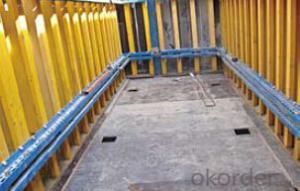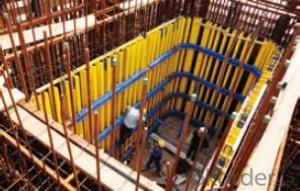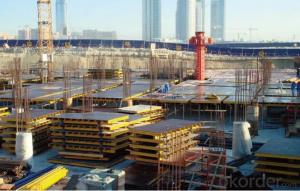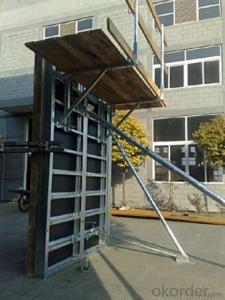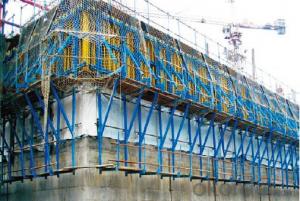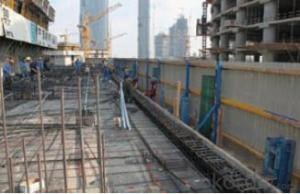Shaft platform S40 System for Formwork and Scaffolding
- Loading Port:
- Tianjin
- Payment Terms:
- TT OR LC
- Min Order Qty:
- 50 m²
- Supply Capability:
- 1000 m²/month
OKorder Service Pledge
Quality Product, Order Online Tracking, Timely Delivery
OKorder Financial Service
Credit Rating, Credit Services, Credit Purchasing
You Might Also Like
Shaft Platform
As operating platform, the shaft platform is mainly used in the concrete pouring of elevator shaft,
equipment shaft, stair shaft of high-rise building and so on.
Characteristics:
◆ The length of shaft beam is adjustable.
◆ Flexible structure makes lifting easier.
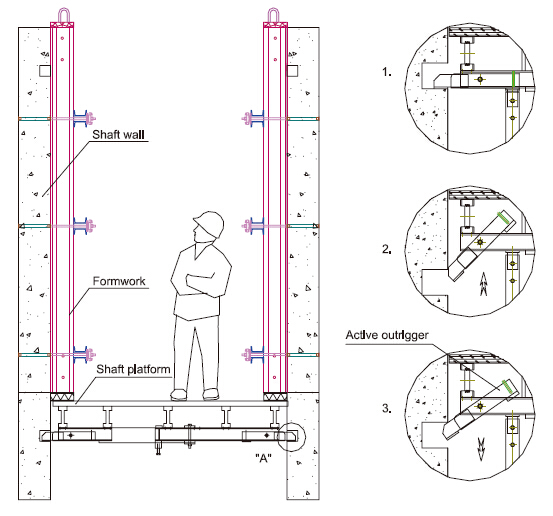
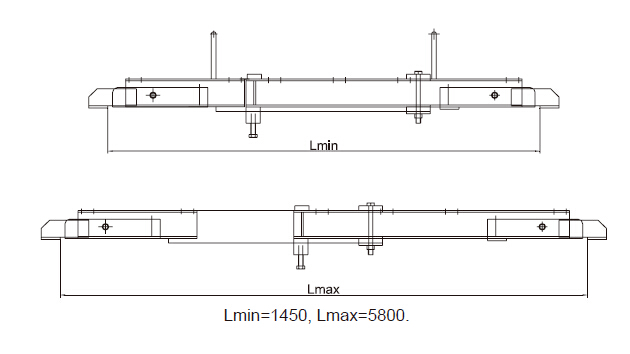
- Q: Can steel formwork be used in bridge construction projects?
- Yes, steel formwork can be used in bridge construction projects. Steel formwork offers several advantages such as durability, flexibility, and reusability, making it a suitable choice for constructing bridges. It provides the necessary support and structure during the concrete pouring process, ensuring the bridge's strength and stability. Additionally, steel formwork allows for faster construction and can be customized to meet specific design requirements, making it a preferred option for many bridge construction projects.
- Q: How does steel formwork handle formwork removal and storage?
- The durability and strength of steel formwork make it highly suitable for the removal and storage of formwork. When it comes to removing formwork, steel formwork can be easily taken apart and removed from the concrete structure. This is mainly because steel formwork is modular, making it easy to dismantle and reassemble. Steel formwork systems often consist of standard-sized panels that can be quickly and efficiently removed by loosening the connecting bolts or clips. This ensures that the formwork can be easily dismantled without causing damage to the concrete structure or the formwork itself. Additionally, steel formwork is lightweight, making it easy to handle during removal and reducing the risk of accidents or injuries. In terms of storage, steel formwork has several advantages. Firstly, it can be stacked and stored in a compact manner, saving space on construction sites or in storage facilities. The modular design of steel formwork panels allows for easy stacking and organization, ensuring efficient storage without taking up excessive space. Furthermore, steel formwork is more resistant to damage from weather conditions compared to other materials like wood or plywood. It can withstand exposure to rain, sunlight, and temperature fluctuations without warping, rotting, or deteriorating. This durability makes steel formwork reliable for long-term storage, as it can be reused multiple times without significant degradation. In conclusion, steel formwork is an excellent solution for formwork removal and storage. Its strength and durability allow for easy dismantling and removal, while its modular design and compact storage capabilities make it ideal for efficient storage. With these advantages, steel formwork contributes to increased productivity and cost-effectiveness in construction projects.
- Q: Can steel formwork be used for industrial construction projects?
- Yes, steel formwork can be used for industrial construction projects. Steel formwork offers several advantages such as durability, strength, and reusability, making it suitable for heavy-duty applications in industrial construction. It provides a stable and rigid structure to support concrete during the casting process, ensuring accurate and high-quality results. Additionally, steel formwork can withstand harsh weather conditions and repetitive use, making it ideal for industrial projects that require long-term and reliable formwork systems.
- Q: Can steel formwork be used for both manual and mechanical concrete pouring?
- Yes, steel formwork can be used for both manual and mechanical concrete pouring. Steel formwork is known for its durability and strength, making it suitable for handling the pressure and weight of concrete, whether it is poured manually or mechanically. It provides a stable and rigid structure that can withstand the forces exerted during pouring and curing of concrete. Additionally, steel formwork is versatile and can be easily adjusted or reassembled to accommodate different shapes and sizes of concrete structures. Hence, it is commonly used in construction projects where both manual and mechanical concrete pouring methods are employed.
- Q: What are the common safety certifications for steel formwork?
- Some common safety certifications for steel formwork include ISO 9001:2015, OHSAS 18001:2007, and CE marking. These certifications ensure that the steel formwork meets international standards for quality management, occupational health and safety, and compliance with European Union regulations.
- Q: What is the lifespan of steel formwork compared to other types of formwork?
- The lifespan of steel formwork is generally longer compared to other types of formwork. Steel is a highly durable material that can withstand heavy loads and extreme weather conditions, making it ideal for construction purposes. With proper maintenance and care, steel formwork can last for several decades. In comparison, other types of formwork such as wooden or plastic formwork have a shorter lifespan. Wood is susceptible to rotting, warping, and termite infestation, which can significantly reduce its lifespan. Plastic formwork, while lightweight and easy to handle, may deteriorate over time due to exposure to UV radiation and general wear and tear. Steel formwork also offers the advantage of being reusable. Once a concrete structure is completed, the steel formwork can be dismantled and used for other construction projects, reducing the need for new formwork and minimizing waste. Although steel formwork may require a larger upfront investment compared to other materials, its longer lifespan and reusability make it a cost-effective choice in the long run. Additionally, steel formwork provides excellent structural stability, ensuring the integrity and quality of the concrete structure being formed.
- Q: Can steel formwork be used for concrete beams with varying cross-sections?
- Yes, steel formwork can be used for concrete beams with varying cross-sections. Steel formwork is versatile and can be easily adjusted and modified to accommodate different shapes and sizes of concrete beams. This flexibility makes it an ideal choice for construction projects that require varying cross-sections in the concrete beams.
- Q: How does steel formwork contribute to the speed of construction?
- There are several ways in which steel formwork speeds up construction. Firstly, steel is a strong and durable material, allowing for faster construction as it can withstand the pressure and weight of the concrete. This means that larger formwork sections can be used, reducing the number of components and speeding up assembly. Secondly, steel formwork is highly reusable. Unlike timber formwork, it can be used for multiple projects, saving time and resources. It can also be easily assembled and disassembled, allowing for faster turnaround times. In addition, steel formwork is adaptable and customizable, fitting different shapes and sizes. This eliminates the need for custom-made formwork, which is costly and time-consuming. Furthermore, steel formwork is resistant to weather conditions, unlike timber formwork. This allows construction to continue even in adverse weather, minimizing delays and maintaining speed. Lastly, steel formwork provides a smooth finish to the concrete structure, eliminating the need for additional finishing work like plastering or sanding. In conclusion, steel formwork speeds up construction by being durable, reusable, adaptable, weather-resistant, and providing a smooth finish. These factors combine to reduce construction time, improve efficiency, and accelerate the overall process.
- Q: What are the different types of tie systems used in steel formwork?
- There are several different types of tie systems that are commonly used in steel formwork in construction projects. These tie systems are designed to provide stability and support to the formwork during the concrete pouring process. Some of the main types of tie systems used in steel formwork include: 1. Tie rods and wing nuts: This is the most commonly used tie system in steel formwork. It consists of steel rods that are inserted through the formwork panels and secured with wing nuts. This system allows for quick and easy assembly and disassembly of the formwork. 2. Shear connectors: Shear connectors are used in situations where there is a need to transfer shear forces between the formwork and the concrete. These connectors typically consist of steel bars that are embedded in the concrete and connected to the formwork. 3. Steel form ties: Steel form ties are used to hold the formwork panels together and maintain the desired shape and alignment during concrete pouring. These ties are typically made of steel and are available in various lengths and sizes to accommodate different formwork requirements. 4. Adjustable formwork systems: These systems are designed to provide flexibility in adjusting the formwork to different shapes and sizes. They often incorporate adjustable brackets and clamps that allow for easy and precise alignment of the formwork panels. 5. Stay-in-place formwork systems: Stay-in-place formwork systems are designed to remain in place after the concrete has cured, eliminating the need for formwork removal. These systems are typically used in applications where the formwork is intended to become a permanent part of the structure, such as in bridges or tunnels. Overall, the choice of tie system in steel formwork will depend on factors such as the project requirements, structural design, and the specific conditions of the construction site. It is important to select a tie system that can provide the necessary stability and support for the formwork, while also considering factors such as ease of installation, reusability, and cost-effectiveness.
- Q: How does steel formwork handle different concrete slump values?
- Steel formwork is a versatile and robust solution that can effectively handle different concrete slump values. Slump refers to the consistency or fluidity of concrete, and it is measured in terms of its workability. Steel formwork is designed to accommodate various slump values due to its inherent strength and durability. Firstly, steel formwork provides excellent support and stability to the concrete during the pouring and curing process. It can withstand the pressure exerted by the wet concrete, regardless of its slump value. The rigid structure of steel formwork ensures that it maintains its shape and integrity, even with high slump concrete. Additionally, steel formwork offers flexibility in terms of adjusting the formwork panels to suit different slump values. The panels can be easily adjusted or repositioned to create the desired shape or size for the concrete structure. This adaptability allows steel formwork to efficiently accommodate varying slump values without compromising the quality or integrity of the final concrete product. Furthermore, steel formwork provides a smooth and even surface finish for the concrete, irrespective of its slump value. The steel panels are precisely manufactured to ensure a consistent and uniform surface finish, enhancing the overall aesthetics of the concrete structure. This is particularly important when dealing with different slump values as it ensures a visually appealing and professional end result. In conclusion, steel formwork is well-equipped to handle different concrete slump values due to its strength, durability, and flexibility. It provides excellent support, stability, and adaptability during the pouring and curing process, resulting in a high-quality finished product. Whether the concrete has a low or high slump value, steel formwork consistently delivers a smooth and visually appealing surface finish, making it a reliable choice for various construction projects.
Send your message to us
Shaft platform S40 System for Formwork and Scaffolding
- Loading Port:
- Tianjin
- Payment Terms:
- TT OR LC
- Min Order Qty:
- 50 m²
- Supply Capability:
- 1000 m²/month
OKorder Service Pledge
Quality Product, Order Online Tracking, Timely Delivery
OKorder Financial Service
Credit Rating, Credit Services, Credit Purchasing
Similar products
Hot products
Hot Searches
Related keywords
